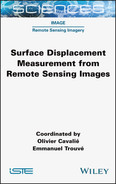Preface
This book is part of ISTE–Wiley’s SCIENCES series and belongs to the Image field of the Engineering and Systems department. The Image field covers the entire processing chain, from acquisition to interpretation, by analyzing the data provided by various imaging systems. This field is split into seven subjects, including remote sensing imagery (RSI). Based on this subject, we proposed a series of books that would portray diverse and comprehensive topics related to advanced remote sensing images and their applications for Earth observation (EO). There has been an increasing demand for the monitoring and prediction of our planet’s evolution on local, regional and global scales. Hence, airborne, space-borne and ground-based platforms with active and passive sensors have been used to acquire images that measure several features at various spatial and temporal resolutions over the past few decades.
RSI has become a broad multidisciplinary domain, attracting scientists across the diverse fields of science and engineering. The books proposed in this RSI series aim to present state-of-the-art scientific knowledge about the primary sources of images acquired by optical and radar sensors. The books cover the processing methods that have been developed by the signal and image processing community to extract useful information for end-users for an extensive range of EO applications.
Each RSI book focuses on a general topic, such as change detection, surface displacement measurement, target detection, model inversion or data assimilation. We dedicate this second book of the RSI series to the measurement of displacements on the Earth’s surface using RSI. It presents the main approaches that are used to derive displacement information from image pairs or image time series using optical and synthetic aperture radar (SAR) data. Following the numerous studies conducted in this domain, we divide this book into methodology and applications.
The first part, Theory, Principles and Methodology, is dedicated to the wide range of methods that have been developed to measure displacement fields from remote sensing images. Chapter 1 provides an overview of the main space missions devoted to EO, which have been used to acquire optical and SAR images for more than 40 years. From the archives of space agencies to future missions, this chapter presents the history and the main characteristics of the data processed to measure the Earth’s topography and surface displacement. Chapters 2 and 3 present the first group of methods developed, which measure displacement from the radiometry of images acquired at different dates, for optical and SAR images, respectively. These methods based on template matching are known as correlation or offset tracking techniques. These chapters include a brief description of the sensor geometry that is required to transform the measured offsets into velocities and to evaluate the potential and limits of this approach. Chapters 4, 5 and 6 examine the second group of methods, which use the phase of SAR images to derive surface displacement using interferometry (InSAR). The principle of InSAR, the geometric and statistical issues and the first processing steps are described in Chapter 4, including the limitations due to atmospheric artifacts. Chapter 5 shows how time-series InSAR methods, namely persistent scatterer and small baseline approaches, succeed in measuring centimeter- and even millimeter-scale deformations. Finally, Chapter 6 focuses on the methods that have been developed to unwrap the phase and to take the phase closure principle into account, improving the results or discovering hidden phenomena.
The second part, Applications for Surface Displacements, exhaustively covers the use of SAR interferometry and image correlation to retrieve the Earth’s surface displacements. Indeed, the first application of InSAR that made the cover of Nature, in April 1993, was for the measurement of earthquake movements. Chapter 7 is thus dedicated to measuring tectonic displacements and showing how InSAR and image correlation have been used over time to monitor more subtle tectonic motions of the Earth. Next, Chapter 8 describes how measuring surface displacement is crucial to understanding the dynamics of volcanoes. In addition to natural phenomena, some of the Earth’s surface deformations are induced by human activities. Chapter 9 reviews all kinds of human-induced signals and how InSAR is beneficial to monitoring them. Chapters 10 and 11 focus on surface motions due to gravity, namely landslide and glacier dynamics. Finally, the last chapter opens up the field of image correlation by cleverly taking advantage of the small spatial baseline and the time lag between the instruments imaging the Earth in different spectral bands onboard the very same satellite.
This book offers for the first time a complete overview of the methodological approaches deployed for the deformation measurement of the Earth’s surface using RSI and their applications to the monitoring of major geophysical phenomena. Over the last few years, a virtuous circle between space agencies and scientists has developed. Indeed, in the last 20 years, the cost of satellite images has decreased drastically, the quantity of data has increased and the performance of data processing algorithms has greatly improved. As a result, the maturity of the remote sensing community now allows near real-time observation of the Earth’s surface deformation, enhancing our capability to detect and mitigate natural hazards substantially.
Olivier CAVALIÉ
Coordinator of the book
Emmanuel TROUVÉ
Coordinator of the book and head of the “Remote Sensing Imagery” subject
Avik BHATTACHARYA
Head of the “Remote Sensing Imagery” subject
February 2022
